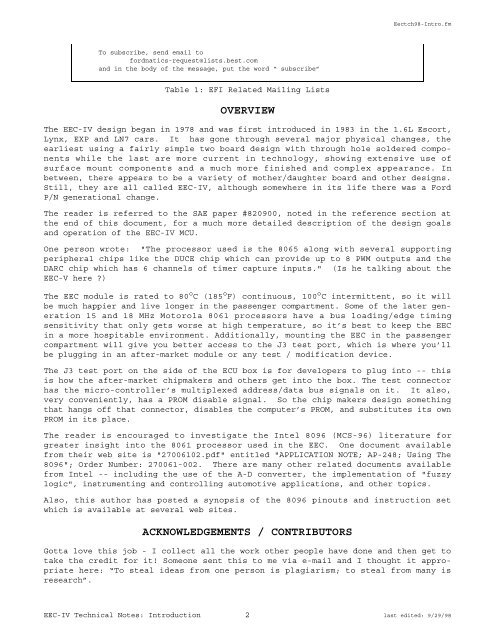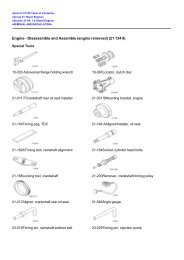TECHNICAL NOTES ON THE EEC-IV MCU - Auto diagnostics
TECHNICAL NOTES ON THE EEC-IV MCU - Auto diagnostics
TECHNICAL NOTES ON THE EEC-IV MCU - Auto diagnostics
You also want an ePaper? Increase the reach of your titles
YUMPU automatically turns print PDFs into web optimized ePapers that Google loves.
To subscribe, send email to<br />
fordnatics-request@lists.best.com<br />
and in the body of the message, put the word “ subscribe”<br />
Table 1: EFI Related Mailing Lists<br />
OVERVIEW<br />
Eectch98-Intro.fm<br />
The <strong>EEC</strong>-<strong>IV</strong> design began in 1978 and was first introduced in 1983 in the 1.6L Escort,<br />
Lynx, EXP and LN7 cars. It has gone through several major physical changes, the<br />
earliest using a fairly simple two board design with through hole soldered components<br />
while the last are more current in technology, showing extensive use of<br />
surface mount components and a much more finished and complex appearance. In<br />
between, there appears to be a variety of mother/daughter board and other designs.<br />
Still, they are all called <strong>EEC</strong>-<strong>IV</strong>, although somewhere in its life there was a Ford<br />
P/N generational change.<br />
The reader is referred to the SAE paper #820900, noted in the reference section at<br />
the end of this document, for a much more detailed description of the design goals<br />
and operation of the <strong>EEC</strong>-<strong>IV</strong> <strong>MCU</strong>.<br />
One person wrote: "The processor used is the 8065 along with several supporting<br />
peripheral chips like the DUCE chip which can provide up to 8 PWM outputs and the<br />
DARC chip which has 6 channels of timer capture inputs." (Is he talking about the<br />
<strong>EEC</strong>-V here ?)<br />
The <strong>EEC</strong> module is rated to 80 o C (185 o F) continuous, 100 o C intermittent, so it will<br />
be much happier and live longer in the passenger compartment. Some of the later generation<br />
15 and 18 MHz Motorola 8061 processors have a bus loading/edge timing<br />
sensitivity that only gets worse at high temperature, so it’s best to keep the <strong>EEC</strong><br />
in a more hospitable environment. Additionally, mounting the <strong>EEC</strong> in the passenger<br />
compartment will give you better access to the J3 test port, which is where you’ll<br />
be plugging in an after-market module or any test / modification device.<br />
The J3 test port on the side of the ECU box is for developers to plug into -- this<br />
is how the after-market chipmakers and others get into the box. The test connector<br />
has the micro-controller’s multiplexed address/data bus signals on it. It also,<br />
very conveniently, has a PROM disable signal. So the chip makers design something<br />
that hangs off that connector, disables the computer’s PROM, and substitutes its own<br />
PROM in its place.<br />
The reader is encouraged to investigate the Intel 8096 (MCS-96) literature for<br />
greater insight into the 8061 processor used in the <strong>EEC</strong>. One document available<br />
from their web site is "27006102.pdf" entitled "APPLICATI<strong>ON</strong> NOTE; AP-248; Using The<br />
8096"; Order Number: 270061-002. There are many other related documents available<br />
from Intel -- including the use of the A-D converter, the implementation of "fuzzy<br />
logic", instrumenting and controlling automotive applications, and other topics.<br />
Also, this author has posted a synopsis of the 8096 pinouts and instruction set<br />
which is available at several web sites.<br />
ACKNOWLEDGEMENTS / C<strong>ON</strong>TRIBUTORS<br />
Gotta love this job - I collect all the work other people have done and then get to<br />
take the credit for it! Someone sent this to me via e-mail and I thought it appropriate<br />
here: “To steal ideas from one person is plagiarism; to steal from many is<br />
research”.<br />
<strong>EEC</strong>-<strong>IV</strong> Technical Notes: Introduction 2 last edited: 9/29/98




